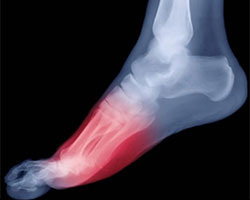- Home
- Foot & Ankle Conditions
- Pediatric Conditions
- Avascular Necrosis
Avascular Necrosis: causes, symptoms and treatment options

What Is Avascular Necrosis of the foot (Freiberg's Disease)?
Avascular Necrosis (AVN), also called Freiberg's disease, osteonecrosis, or Freiberg infraction disease, is the death of bone tissue in the forefoot due to interruption of the blood supply. It’s an osteochondral condition, meaning it affects the cartilage and underlying bone in a joint.
It usually occurs in the second toe (the toe next to the big toe), but it can occur in the third or even fourth toes. It is a relatively rare musculoskeletal condition, though its complications can be quite serious. Freiberg disease in adults is possible, but it is more common in adolescents.
- What causes avascular necrosis?
- What are the symptoms of avascular necrosis?
- How is Freiberg’s disease diagnosed?
- What is Freiberg's disease treatment?
- Conservative treatment options
- Surgical Options
- Reach out to UFAI for your pediatric foot and ankle conditions
- How rare is Freiberg's disease?
- Can Freiberg's disease go away?
- Are there Freiberg infraction taping techniques?
-
Foot and Ankle Surgeon and Director of University Foot and Ankle Institute
Dr. Bob Baravaria DPM, FACFAS is a Board-Certified Podiatric Foot and Ankle Specialist. He is an assistant clinical professor at the UCLA School of Medicine and serves as Director of University Foot and Ankle Institute.
Dr. Baravarian has been involved in athletics his entire life and played competitive tennis in high school and college. He has an interest in sports medicine, arthritis therapy, and trauma/reconstructive surgery of the foot and ankle. He is also fluent in five languages (English, French, Spanish, Farsi, and Hebrew),
 We thought our current situation was well addressed as the clinic was able to effectively repair the nearly new orthotic that h...Ron E.
We thought our current situation was well addressed as the clinic was able to effectively repair the nearly new orthotic that h...Ron E. Overall, it was a great experience. I've been coming to Dr. Kellman for about a year and he and his staff are very helpful.Vanessa W.
Overall, it was a great experience. I've been coming to Dr. Kellman for about a year and he and his staff are very helpful.Vanessa W. Very calming atmosphere. Dr Naei very nice and explained everything so I could understand everything. Staff was super helpful a...Elke T.
Very calming atmosphere. Dr Naei very nice and explained everything so I could understand everything. Staff was super helpful a...Elke T. ExcellentDebasish M.
ExcellentDebasish M. Everyone was friendly and professional.Victor L.
Everyone was friendly and professional.Victor L. Very efficient and an excellent serviceHorwitz J.
Very efficient and an excellent serviceHorwitz J. Chaos in the office checkin. We weren’t forewarned about the iPad data collection. That made me late for a following appointmen...Carl C.
Chaos in the office checkin. We weren’t forewarned about the iPad data collection. That made me late for a following appointmen...Carl C. Dr Nalbandian is an exceptional doctor and person. The staff respectfully & compently delt with an issue I had regarding a prev...Karen M.
Dr Nalbandian is an exceptional doctor and person. The staff respectfully & compently delt with an issue I had regarding a prev...Karen M. Professional like none other. I’m super picky with who I appoint as my PC or Specialist so I went through the rounds of intervi...Arthur A.
Professional like none other. I’m super picky with who I appoint as my PC or Specialist so I went through the rounds of intervi...Arthur A. Visiting the office is a pleasurable occurance.Thomas J.
Visiting the office is a pleasurable occurance.Thomas J. Dr Kelman and his staff are always wonderfully caring and respectful to my father who has Alzheimer's dementia.Erland E.
Dr Kelman and his staff are always wonderfully caring and respectful to my father who has Alzheimer's dementia.Erland E. Thank you for being there for your patients.Dieter B.
Thank you for being there for your patients.Dieter B.
